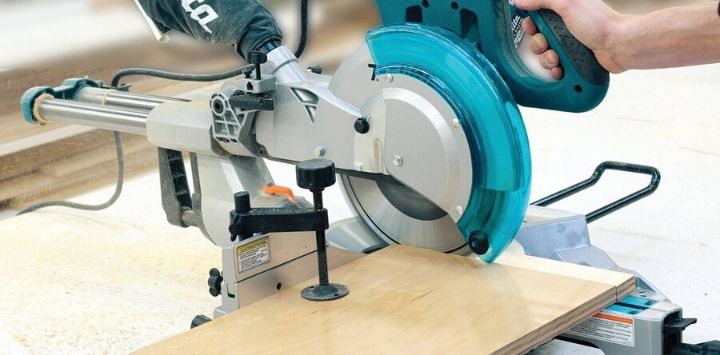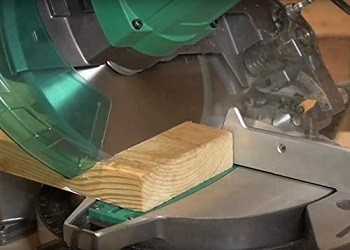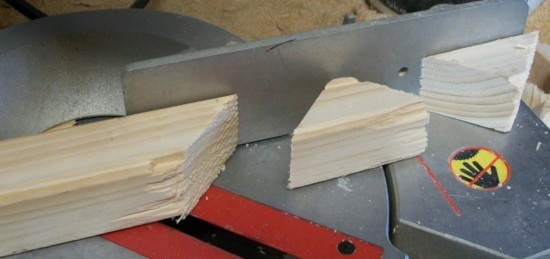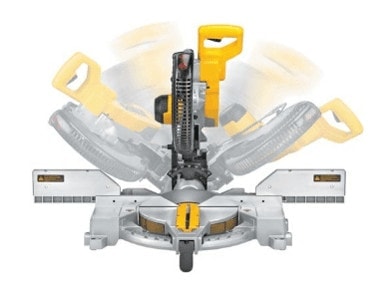4 Miter Saw Uses – What Can It Be Used For?
-
Pete Ortiz
- Last updated:

The primary function of a miter saw is to make angled cuts. If you’ve invested in one, you’ve decided that you need accurate angle cuts and don’t want to spend the time or energy making them with a hand saw or circular saw or go to the trouble of using a table saw. A miter saw requires a stable surface like a workbench or a sturdy table to support it.
How does a miter saw work?
Although there are differences depending on the manufacturer and features you want, miter saws are all built basically the same way. Based on the miter angle you want, you can rotate the table.
Most miter saws also have an angle adjustment, so you can position the blade to make bevel cuts. A primary safety feature you’ll want is a blade cover that only moves out of the way when you lower the spinning blade toward the table. There are three main types of miter saws: standard, compound, and sliding compound, all of which can make the following cuts.
The 4 Types of Angled Cuts
The best miter saws can perform four basic cuts. A crosscut goes straight across the wood. A miter angle is a basic angled cut used primarily for framing and goes across the face of the wood. Cuts made relative to the edge of the wood are beveled cuts, and they are used to install weather stripping. When you combine both kinds of cuts into one, it’s a compound cut.
1. Crosscut
Cuts across a board and against the grain are crosscuts. Cuts along the wood grain are almost always much longer and are called rips. Because the cuts a miter saw can make are limited to the diameter of the saw blade, most straight cuts with a miter saw are crosscuts.
You can make crosscuts with most saws, including hand saws. You can make better crosscuts with minimal effort with table saws. You can also make them with a circular saw. You can make crosscuts to make boards the correct length for framing to basic furniture construction. They’re generally the crudest-looking cuts, but because there is minimal wood-to-wood contact, they’re also the weakest.
2. Miter cut
A miter cut is angled along a crosscut face, usually at a 45-degree angle. They’re commonly used for projects like installing trim, where you need two pieces to fit snugly in a corner.
They aren’t used for strength in that case but because they are attractive. They’re also used when installing baseboards and crown molding. Other uses for miter cuts are making boxes, framing pictures, and making frames for windows, doors, and pipes.
3. Bevel cut
Bevel cuts are angled cuts made relative to the edge of the board. You can attempt to make them with hand tools, but they are more difficult to use. To make a good beveled cut, it’s recommended that you use a power tool. Like the miter cut, most beveled cuts are made at 45 degrees. They are not only the most attractive but also the strongest.
Bevel cuts are used in installing trim and molding when you need to take it around a corner. You can also use beveled cuts to install stripping for weather or to make geometric shapes.
4. Compound cut
The most complicated angled cut combines both miter and bevel cuts. You are cutting it at an angle across the grain and at an angle relative to the wood’s edge. It’s an intimidating cut to make, and when someone gets frustrated installing trim, it is most often in trying to get a compound angle cut just right.
Trying to get a trim project right isn’t the only time you’d need to make one of these cuts. They are frequently also used in making serving trays and cradles. If you’re trying to make something look a little more sophisticated, you might try using one of these complex cuts.
Conclusion
Making simple and complex cuts with a hand saw is possible, but it’s easier and less labor-intensive to use a miter saw. It provides a quick, painless way to line up any of the four angled cuts. Although circular saws can also rip boards and make angled cuts, they’re not as accurate or stable as using a miter saw with a heavy base. Miter saws are essential when installing crown molding and baseboards in your home.
See Also:
Contents






